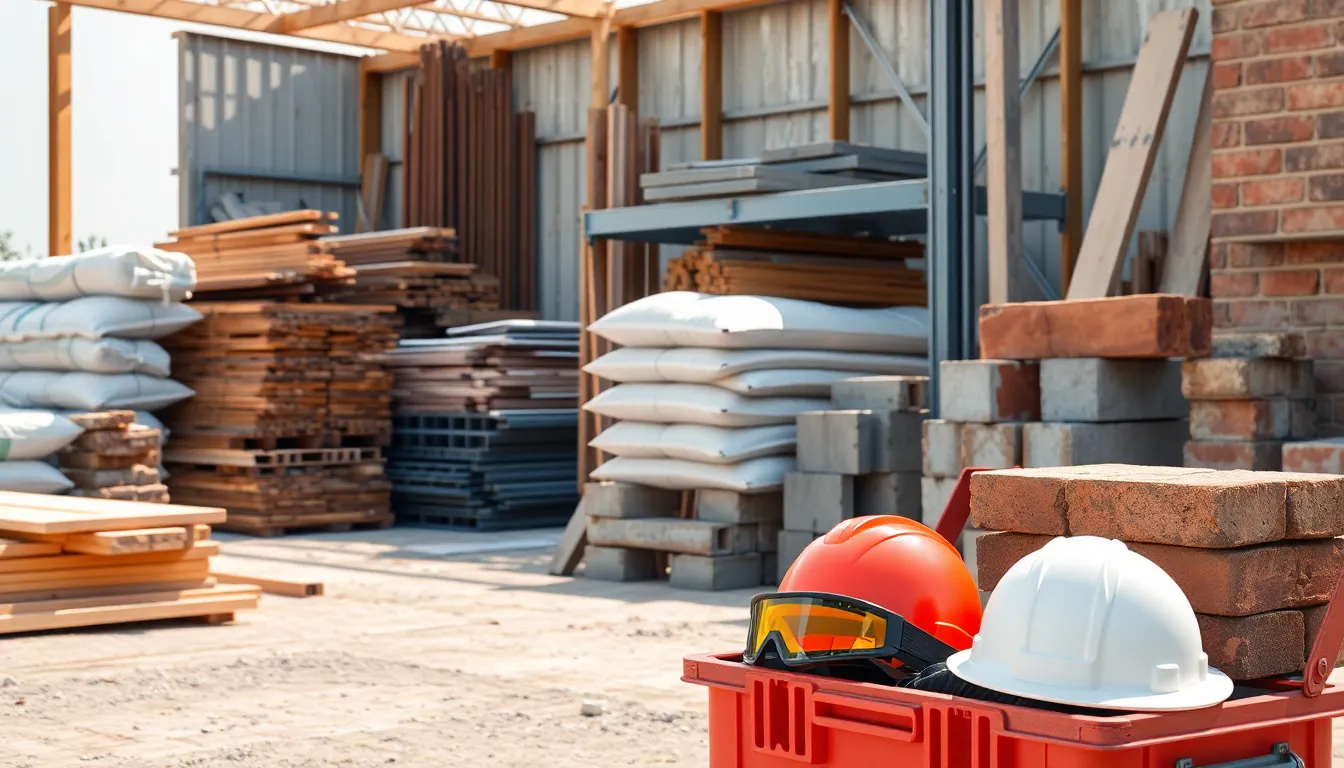Building a home is an exciting journey, but it’s also one that requires careful planning and the right materials. Home building supplies play a crucial role in turning blueprints into reality. From foundational elements to finishing touches, the quality and selection of these materials can significantly impact the longevity and aesthetic appeal of a home.
With countless options available, navigating the world of home building supplies can feel overwhelming. Understanding the essentials—like lumber, insulation, roofing materials, and fixtures—can empower homeowners and builders alike to make informed decisions. In this article, readers will discover the key supplies needed for a successful home construction project, ensuring they’re well-equipped to create their dream living space.
Table of Contents
ToggleOverview of Home Building Supplies
Home building supplies encompass essential materials required for constructing or renovating residential structures. These supplies not only ensure the structural integrity of the home but also contribute to its aesthetic appeal. Key categories of supplies include:
- Lumber: Used for framing, flooring, and cabinetry, lumber provides the foundational framework. Common types include pine, oak, and plywood.
- Insulation: Vital for energy efficiency, insulation materials such as fiberglass, foam board, and spray foam help regulate temperature and reduce energy costs.
- Roofing Materials: Options like asphalt shingles, metal roofing, and tiles offer various levels of durability and style. They protect the home from environmental elements.
- Drywall: Used for interior walls and ceilings, drywall is available in standard, moisture-resistant, and fire-rated types, ensuring safe and versatile construction.
- Flooring: Choices range from hardwoods and laminates to tiles and carpets. Each type delivers unique characteristics suitable for different spaces in a home.
- Windows and Doors: These provide security, energy efficiency, and aesthetic value. Materials such as vinyl, wood, and fiberglass offer varied functionality and design.
- Fixtures: Includes items like faucets, light fixtures, and cabinetry hardware that enhance both function and design throughout the home.
Assessing quality and suitability for specific projects helps homeowners and builders select the right materials. Understanding each category equips them to make informed decisions, ultimately contributing to successful construction outcomes.
Types of Home Building Supplies

Various home building supplies play crucial roles in construction projects. These supplies can be categorized into structural materials, finishing materials, and tools and equipment.
Structural Materials
Structural materials form the backbone of any home. Common types include:
- Lumber: Used for framing walls, roofs, and floors. It’s essential for support and stability.
- Concrete: Provides strength for foundations, driveways, and patios. Its durability against weather extremes offers long-lasting performance.
- Steel: Utilized in commercial and residential buildings for reinforcement, allowing for larger spans and greater loads.
- Masonry: Comprises bricks, blocks, and stones, used for walls. It enhances aesthetics and provides insulation.
Finishing Materials
Finishing materials enhance a home’s appearance and functionality. Key categories include:
- Drywall: Forms interior walls and ceilings, offering a smooth surface for painting.
- Flooring: Includes options like hardwood, laminate, tile, and carpet, contributing to design and comfort.
- Paint: Protects surfaces while offering color and style, affecting both indoor and outdoor aesthetics.
- Cabinetry and Countertops: Essential for kitchens and bathrooms, these materials provide storage and workspaces, impacting overall design.
Tools and Equipment
- Power Tools: Drills, saws, and nail guns facilitate efficient construction.
- Hand Tools: Hammers, screwdrivers, and levels are critical for precision and manual tasks.
- Safety Equipment: Hard hats, gloves, and goggles ensure worker protection on-site.
- Measuring Tools: Tape measures and laser levels guarantee accuracy in measurements and alignments.
Choosing the Right Home Building Supplies
Selecting appropriate home building supplies is crucial for project success. Quality materials affect overall durability, appearance, and function.
Factors to Consider
- Quality: Evaluating durability and performance characteristics of materials ensures longevity.
- Cost: Comparing prices among different suppliers helps in budgeting efficiently without compromising quality.
- Suitability: Assessing the specific needs of the project, such as climate factors and local building codes, contributes to optimal choices.
- Sustainability: Considering eco-friendly materials supports environmental stewardship and can enhance energy efficiency.
- Availability: Ensuring local suppliers stock necessary materials prevents delays in the construction timeline.
Where to Buy
- Local Hardware Stores: Visiting local retailers offers immediate access to a wide range of supplies and expert advice.
- Home Improvement Centers: Shopping at major chains provides convenience, competitive pricing, and a vast selection of materials.
- Specialty Suppliers: Consulting specialty shops for niche materials ensures unique, high-quality offerings tailored to specific needs.
- Online Retailers: Exploring e-commerce platforms facilitates price comparison and product reviews, but delivery considerations must align with project timelines.
- Wholesale Distributors: Purchasing in bulk from distributors can lower costs, especially for larger projects, while ensuring a consistent supply of materials.
Cost Considerations
Cost plays a crucial role in the selection of home building supplies. Understanding budgeting and exploring cost-effective alternatives helps ensure financial feasibility during construction.
Budgeting for Home Building Supplies
Budgeting for home building supplies involves assessing total project costs, including materials and labor. Homeowners should begin by estimating the quantity and type of supplies needed based on project specifications. Creating a detailed list of essential materials helps prioritize spending. Prices for lumber, insulation, and fixtures can fluctuate significantly based on market trends. Allocating funds for unexpected expenses can prevent project delays, ensuring flexibility within the budget. Regularly reviewing the budget against actual expenditures keeps homeowners on track throughout the building process.
Cost-Effective Alternatives
Homeowners should consider cost-effective alternatives to traditional building supplies. Reclaimed materials, such as salvaged wood and recycled metal, present environmentally friendly options that often reduce costs. Engineered wood products can replace solid wood, offering strength at a lower price. Various types of insulation, like foam board or cellulose, can provide effective thermal performance while being budget-friendly. Additionally, opting for energy-efficient windows and appliances may incur higher upfront costs but lead to long-term savings through reduced energy bills. Researching multiple suppliers and comparing prices ensures homeowners find the best deals on necessary supplies.
Selecting the right home building supplies is crucial for any construction project. Quality materials not only enhance the durability of the home but also contribute to its overall aesthetic appeal. Homeowners and builders should prioritize careful planning and budgeting to ensure they choose materials that fit their needs and financial constraints.
By exploring various purchasing options and considering factors like sustainability and cost, they can make informed decisions that lead to successful outcomes. Investing in quality supplies now can save money and headaches in the long run, ultimately helping to create a dream living space that stands the test of time.



